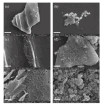Iron-modified biochar modulates root metabolism, mitigates antimony accumulation and enhances growth in rice (Oryza sativa)
- PMID: 40781602
- PMCID: PMC12333156
- DOI: 10.1186/s12870-025-07071-y
Iron-modified biochar modulates root metabolism, mitigates antimony accumulation and enhances growth in rice (Oryza sativa)
Abstract
Background: Antimony (Sb), with low biodegradability and high bioavailability in plants, poses significant health risks via the food chain due to its chronic toxicity and carcinogenicity. Modified biochar represents a promising amendment for ecological remediation of metal-contaminated croplands, yet the efficacy and mechanisms of its application in mitigating Sb accumulation and improving plant growth in Sb-polluted agricultural systems remain inadequately elucidated and require systematic investigation.
Results: In this study, pristine biochar (BC) and iron-modified biochar (FeBC) were prepared from pomelo peel flesh (PPF; Citrus maxima), and their effects on rice root growth, Sb content, and metabolism under 30 mg/L Sb stress were evaluated. Treatment with 5 g/L BC and 5 g/L FeBC increased root length by 35.04% and 84.60%, respectively, while reducing Sb accumulation in roots by 25.79% and 28.03%, respectively. Root metabolite analysis showed that, compared to BC, FeBC significantly decreased levels of p-coumaroylagmatine, silibinin, and osmanthuside A by 75%, 37%, and 37%, respectively. Conversely, FeBC elevated levels of (S)-actinidine, phaeophorbide A, and 2-keto-6-acetamidocaproate by 187%, 156%, and 122%, respectively. These altered metabolites were enriched in five key metabolic pathways: phenylalanine, tyrosine, and tryptophan biosynthesis; phenylalanine biosynthesis; lysine degradation; tryptophan metabolism; and pantothenate and CoA biosynthesis. Correlation analysis demonstrated significant interrelationships among biochar-induced metabolites, root growth, and Sb accumulation dynamics under Sb stress.
Conclusions: The findings provided the insights that FeBC enhanced rice root metabolism and growth while reducing root Sb accumulation. This study provided a methodological foundation for developing eco-friendly remediation technologies in Sb-contaminated soils to enable safer and more sustainable rice production.
Keywords: Antimony; Iron-modified biochar; Pristine biochar; Root growth; Root metabolism.
© 2025. The Author(s).
Conflict of interest statement
Declarations. Ethics approval and consent to participate: Rice seedlings were collected from the Loudi Agricultural Science Institute in Hunan and identified by Professor Duan Renyan. The methods involved in this study were conducted in accordance with local and national regulations. Consent for publication: All the authors agreed to publish. Competing interests: The authors declare no competing interests.
Figures








Similar articles
-
Efficient cadmium-resistant plant growth-promoting bacteria loaded on pig bone biochar has higher efficiency in reducing cadmium phytoavailability and improving maize performance than on rice husk biochar.J Hazard Mater. 2024 Nov 5;479:135609. doi: 10.1016/j.jhazmat.2024.135609. Epub 2024 Aug 22. J Hazard Mater. 2024. PMID: 39216242
-
Iron-silicon modified biochar for remediation of cadmium/arsenic co-contaminated paddy fields: Is it possible to kill two birds with one stone?J Hazard Mater. 2025 Aug 15;494:138702. doi: 10.1016/j.jhazmat.2025.138702. Epub 2025 May 21. J Hazard Mater. 2025. PMID: 40435623
-
Assessment of biochar filter application in improving chromium stress tolerance and plant physiology in Chinese cabbage (Brassica rapa) under a flow-through water setup.BMC Biotechnol. 2025 Jul 19;25(1):74. doi: 10.1186/s12896-025-01010-3. BMC Biotechnol. 2025. PMID: 40684162 Free PMC article.
-
Combined application of biochar and PGPB on crop growth and heavy metals accumulation: A meta-analysis.Environ Pollut. 2025 Sep 15;381:126626. doi: 10.1016/j.envpol.2025.126626. Epub 2025 Jun 7. Environ Pollut. 2025. PMID: 40490065 Review.
-
AI-assisted systematic review on remediation of contaminated soils with PAHs and heavy metals.J Hazard Mater. 2024 Apr 15;468:133813. doi: 10.1016/j.jhazmat.2024.133813. Epub 2024 Feb 17. J Hazard Mater. 2024. PMID: 38402679
References
-
- Zhu Y, Yang J, Wang L, Lin Z, Dai J, Wang R, et al. Factors influencing the uptake and speciation transformation of antimony in the soil-plant system, and the redistribution and toxicity of antimony in plants. Sci Total Environ. 2020;738: 140232. - PubMed
-
- Bolan N, Kumar M, Sing E, Kumar A, Singh L, Kumar S, et al. Antimony contamination and its risk management in complex environmental settings: A review. Environ Int. 2022;158:106908. - PubMed
-
- Fan J, Chen Y, Li X, Huang J, Zhang X, Chen K, et al. Transcriptomic and metabolomic insights into the antimony stress response of tall fescue (Festuca arundinacea). Sci Total Environ. 2024;933: 172990. - PubMed
-
- Zhao Q, Li J, Tan Z, Li W, Zhang Z, Guan X. Collaborative effects of antimony-arsenic contaminations on microbial communities in the typical antimony mining areas of Southwest China. Sci Total Environ. 2025;975: 179249. - PubMed
MeSH terms
Substances
Grants and funding
LinkOut - more resources
Full Text Sources
Medical

